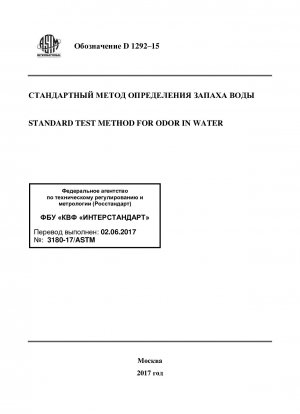ASTM D1292-15
Standard Test Method for Odor in Water&x2009;
- Standard No.
- ASTM D1292-15
- Release Date
- 2015
- Published By
- American Society for Testing and Materials (ASTM)
- Status
- Replace By
- ASTM D1292-15(2021)e1
- Latest
- ASTM D1292-15(2021)e1
- Scope
5.1 The odor of water is a subjective property which is recognized as having a significant effect on its quality. This test is intended to provide a reproducible test method for determining the intensity of odor in waters for comparative or control purposes.
5.2 The test may be useful in checking the quality of raw or treated waters, determining the effectiveness of treatment procedures, or in tracing sources of contamination or leaks in industrial processes.
5.3 The results of the test are very dependent upon the observers, since the sensitivity of individuals to odor is highly variable and changes from day to day. Careful standardization of the conditions is essential.
1.1 This test method8201;2 covers the determination of the odor (that is, the property that affects the sense of smell) of water. A suggested system for classifying odors is given as Annex A1. The test method is applicable to the determination of odor intensity in terms of odor intensity index or threshold odor number.
1.2 Effluents may carry a myriad of compounds, difficult to measure individually, which contribute to odor problems. Combinations of compounds can cause an odor intensity or develop a characteristic that cannot be anticipated from odors of the individual substances.
1.3 Because of the variation in human sensitivity, high precision in determining odor intensity is not possible. There will not always be agreement on odor characteristics by various testers. Odor analysis provides the tool to measure variation in odor intensity at a given sampling point. The degree of variation may indicate the magnitude or importance of an odor problem. Determining the cause of the variation or the source of the objectionable characteristic may define the odor problem better than analysis for individual compounds.
1.4 The values stated in SI or inch-pound units are to be regarded as the standard. The values given in parentheses are for information only.
1.5 This standard does not purport to address all of the safety concerns, if any, associated with its use. It is the responsibility of the user of this standard to establish appropriate safety and health practices and determine the applicability of regulatory limitations prior to use. For specific hazard statements, see the warning statement under 10.1.
ASTM D1292-15 Referenced Document
- ASTM D1066 Standard Practice for Sampling Steam
- ASTM D1129 Standard Terminology Relating to Water
- ASTM D1193 Standard Specification for Reagent Water
- ASTM D2777 Standard Practice for Determination of Precision and Bias of Applicable Methods of Committee D-19 on Water
- ASTM D3370 Standard Practices for Sampling Water from Closed Conduits
ASTM D1292-15 history
- 2021 ASTM D1292-15(2021)e1 Standard Test Method for Odor in Water
- 2015 ASTM D1292-15 Standard Test Method for Odor in Water&x2009;
- 2010 ASTM D1292-10 Standard Test Method for Odor in Water
- 2005 ASTM D1292-05 Standard Test Method for Odor in Water
- 1999 ASTM D1292-86(1999) Standard Test Method for Odor in Water
